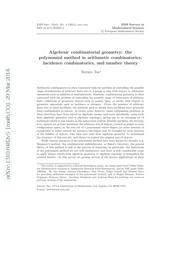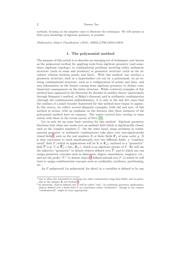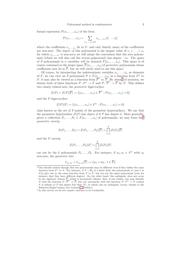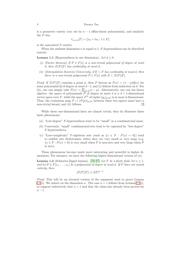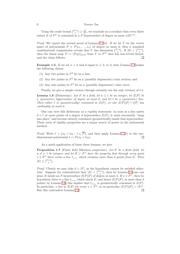Datasheet 搜索 > 贴片电感 > TDK(东电化) > ACM2012-201-2P-T000 数据手册 > ACM2012-201-2P-T000 其他数据使用手册 1/44 页
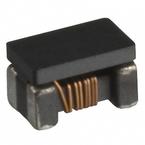
 器件3D模型
器件3D模型¥ 0.534
ACM2012-201-2P-T000 其他数据使用手册 - TDK(东电化)
制造商:
TDK(东电化)
分类:
贴片电感
封装:
0805
描述:
ACM2012-201-2P-T000 200Ω/OHM 0805-201
Pictures:
3D模型
符号图
焊盘图
引脚图
产品图
页面导航:
应用领域在P40
导航目录
ACM2012-201-2P-T000数据手册
Page:
of 44 Go
若手册格式错乱,请下载阅览PDF原文件

arXiv:1310.6482v5 [math.CO] 29 Mar 2014
EMS Surv. Math. Sci. x (201x), xxx–xxx
DOI 10.4171/EMSS/x
EMS Surveys in
Mathematical Sciences
c
European Mathematical Society
Algebraic combinatorial geometry: the
polynomial method in arithmetic combinatorics,
incidence combinatorics, and number theory
Terence Tao
∗
Arithmetic combinatorics is often concerned with the problem of controlling the p ossible
range of behaviours of arbitrary finite sets in a group or ring with respect t o arithmetic
operations such as addition or multiplication. Similarly, combinatorial geometry is often
concerned with the problem of controlling the possible range of behaviours of arbitrary
finite collections of geometric objects such as points, lines, or circles with respect to
geometric operations such as incidence or distance. Given the presence of arbitrary
finite sets in these problems, the methods used to attack these problems have primarily
been combinatorial in nature. In recent years, however, many outstanding problems in
these directions have been solved by algebraic means (and more specifically, using tools
from algebraic geometry and/or algebraic topology), giving rise to an emerging set of
techniques which is now known as the polynomial method. Broadly speaking, the strategy
is to capture (or at least partition) the arbitrary sets of objects (viewed as points in some
configuration space) in the zero set of a polyn omial whose degree (or other measure of
complexity) is under control; for instance, the degree may be bounded by some function
of the number of objects. One then uses tools from algebraic geometry to understand
the structure of this zero set, and thence to control the original sets of objects.
While various instances of the polynomial method have been known for decades (e.g.
Stepanov’s method, the combinatorial nullstellensatz, or Baker’s theorem), the general
theory of this method is still in the process of maturing; in particular, the limitations
of the polynomial method are not well understood, and there is still considerable scope
to apply deeper results from algebraic geometry or algebraic topology to strengthen the
metho d further. In this survey we present several of the known applications of these
∗
The author is supported by a Simons Investigator grant, the James and Carol Collins Chair,
the Mathematical Analysis & Application Research Fund Endowm ent, and by NSF grant DMS-
1266164. He also thanks Ameera Chowdhury, Ben Green, Felipe Voloch and Michael Zieve
for providing additional examples of the polynomial method, and to Holger Brenner, Fabrice
Orgogozo, Kaloyan Slavov, Jonathan Steinbuch and Andreas Wenz for pointing out errors in
previous versions of the manuscript.
Terence Tao, UCLA Department of Mathematics, Los Angeles, CA 90095-1555.
E-mail: tao@@math.ucla.edu
器件 Datasheet 文档搜索
AiEMA 数据库涵盖高达 72,405,303 个元件的数据手册,每天更新 5,000 多个 PDF 文件
